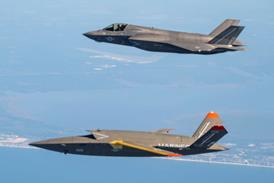Lockheed Martin has flown an F-35 flight test aircraft with the third of five major blocks of software for the first time. The advance represents a key step, as the programme has struggled to deliver an estimated 11.6 million lines of code demanded by fusing the aircraft’s advanced sensors and avionics.
F-35B short take-off and vertical landing (STOVL) variant flight test aircraft BF-4 flew on 5 November with Block 1.0 software installed, Lockheed announced on 15 November.
The 1.5h sortie came six months after the Block 1.0 code had started flying on a surrogate platform – a Boeing 737 modified by BAE Systems into the F-35’s cooperative avionics testbed (CATBird) aircraft.
Lockheed estimates that Block 1.0 accounts for 80% of the Joint Strike Fighter’s total software code, suggesting about 9 million lines of code are written so far.
The F-22, by contrast, requires only 2.2 million lines of code.
 |
|---|
©Lockheed Martin |
The same software block also will be installed on the F-35A conventional take-off and landing variant’s AF-3 and the F-35C carrier variant’s CF-3 flight test aircraft, Lockheed says.
But the F-35 programme faces yet another potential delay and cost overruns, partly caused by software development delays.
Lockheed had previously planned to start flight tests on the Block 1.0 software, which provides the first sensor fusion capability, in the third quarter of 2009.
Software problems emerged as one of the key drivers for the $2.5 billion programme restructuring announced by Secretary of Defense Robert Gates last February. Part of the cost overrun was invested in a new software integration line.
Since then, mechanical reliability failures have also slowed flight tests on the STOVL variant.
Meanwhile, details of a sweeping new analysis of the programme - called the technical baseline review – will be briefed on 22 November to the Defense Acquisition Board, a panel of top decision-makers on major acquisition programmes within the Pentagon. The review warns that the programme faces yet another delay, with a $2.5 to $5 billion cost overrun, according to leaked reports.
Source: Flight International























